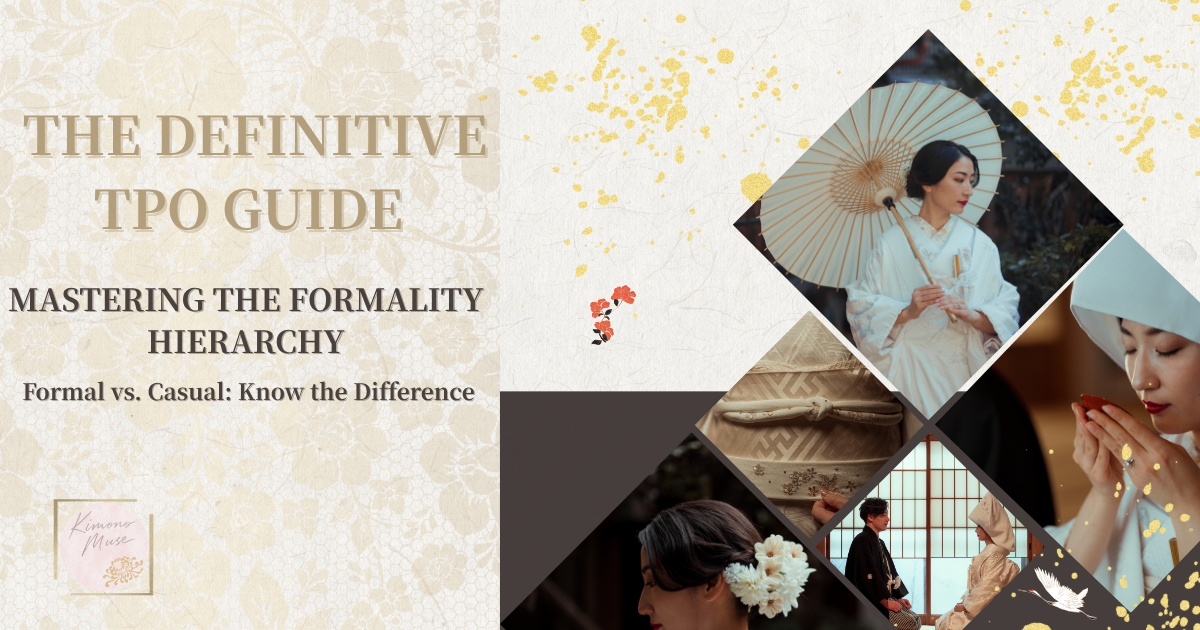“Where can I wear this kimono?”
That simple question is the perfect doorway to a richer and more enjoyable kimono life.
Just like Western clothing, kimono have their own levels of formality.
By choosing the right one for each occasion, you can express an elegant and refined sense of style.
At first, it might feel a little confusing. But once you understand the basics, your coordination options will expand dramatically — and the time you spend thinking “Which kimono should I wear today?” will become something to look forward to.
In this article, we’ll introduce the fundamentals of TPO (Time, Place, Occasion) and the levels of formality in kimono, presented in an easy-to-understand guide for beginners.
From formal to casual, let’s master the basics and create wonderful memories with each kimono that becomes uniquely yours.
What Does the “Rank” of a Kimono Mean?
“Formality” in kimono refers to its level of dressiness — how formal or casual the garment is.
For instance, you wouldn’t attend a friend’s wedding wearing a T-shirt and jeans, right?
It’s the same with kimono — there’s an unspoken dress code for each occasion.
That is what we call the formality level (or rank) of a kimono.
But don’t worry — it’s not something strict or intimidating.
Rather than being a set of rules that limit you, understanding formality helps you wear kimono with confidence anywhere you go. It becomes your trusted guide in expressing elegance.
The secret to determining this formality level actually comes down to just three key points.
Type of kimono (e.g., furisode, hōmongi, komon)
Number of family crests (mon) — five, three, one, or none
Accessories such as obi and footwear (e.g., fukuro-obi, hanhaba-obi, types of zōri)
By skillfully combining these three elements, you can create a perfectly balanced kimono style that suits any TPO.
The Fascinating Balance Between Kimono and Obi: When Formality Flips
Here’s a fun little quiz for your kimono coordination skills!
In kimono, which technique is considered more formal for kimono, yet more casual for obi?
The answer is… dyeing (some).
Interestingly, the relationship between kimono and obi flips when it comes to dyeing (some) and weaving (ori).
A dyed kimono is formal, while a dyed obi is casual — the opposite of what you might expect!
Once you understand this “reversal rule,” you’ll officially be one step closer to the ranks of advanced kimono wearers.
▼ For Kimono: “Some” (Dyeing) Is More Formal
A dyed kimono (some) is considered more formal because its patterns are applied after the fabric is woven, allowing it to become a work of art — almost like a painting on silk. These elegant designs make dyed kimono the stars of formal occasions.
In contrast, woven kimono (ori) are appreciated for their strength and texture, making them ideal for stylish everyday wear.
▼ For Obi: “Ori” (Weaving) Takes the Lead
When it comes to obi, the rule flips. Formal obi are usually woven (ori) with gold and silver threads, giving them a rich, dignified appearance that stands up beautifully against luxurious kimono.
On the other hand, dyed obi (some obi) are more casual — playful accessories that add a touch of individuality to everyday or semi-formal outfits.
Quick Reference Chart: Kimono TPO & Formality
| Formality Level | Men’s Kimono Examples | Women’s Kimono Examples |
|---|---|---|
| Formal Attire | ・Black habutae with five crests (montsuki) |
・Bridal kimono ・Furisode (long-sleeved kimono) ・Black tomesode ・Colored tomesode ・Mofuku (mourning kimono) |
| Semi-Formal Attire |
・Colored habutae rinzu with five crests (with haori) ・Plain omeshi with one crest (with haori) ・Plain tsumugi with one crest (with haori) ・Summer weaves (ro, sha) with one crest (with haori) |
・Furisode ・Colored tomesode (three crests or fewer) ・Hōmongi ・Iromuji (with one or more crests) ・Edo komon (with three crests) ・Tsukesage |
| Dressy Casual (Outing Wear) |
・Omeshi (with haori) ・Tsumugi (with haori) ・Wool (with haori) ・Summer Oshima ・Jōfu (hemp-based summer kimono) |
・Tsukesage ・Edo komon ・Iromuji (without crests) ・Komon ・Omeshi ・Tsumugi |
| Everyday / Casual |
・Omeshi (with haori) ・Wool (with haori) ・Yukata ・Chijimi ・Ro (summer sheer weave) |
・Komon ・Omeshi ・Tsumugi ・Wool ・Yukata |
※This table summarizes the general levels of formality (kaku) of kimono according to typical TPO situations.
Where Am I Going Today? — A Kimono Occasion Map
Now that you’ve discovered the formality level of your kimono from the quick reference chart, it’s time to plan your next outing!
Here are some wonderful destinations that perfectly match each level of formality.
[Formal Wear]
For life’s most memorable milestones and truly special days.
Examples: a close friend’s wedding, official ceremonies, or a Coming-of-Age celebration.
[Semi-Formal Wear]
When you want to balance elegance with a touch of personal style.
Examples: wedding receptions, your child’s entrance or graduation ceremony, or dining at an upscale restaurant.
[Visiting Wear]
For outings that make your heart flutter — when you wish to look your best, just a little more than usual.
Examples: going to the theatre or a concert, visiting art museums, or enjoying a refined lunch with friends.
[Casual Kimono]
For easygoing, everyday joy — wearing kimono freely as part of daily life.
Examples: chatting with friends at a café, window shopping, or joining a summer festival in a yukata.
May this guide inspire you to create beautiful memories with your favorite kimono.
One Kimono, Seven Styles — The Magic of Versatile Dressing
Did you know there are some “magical” kimono that can completely transform depending on how you coordinate them?
These are the moderately formal types such as visiting kimono (hōmongi), tsukesage, iro-muji (solid-colored kimono), and Edo komon.
They sit right in the middle between formal and casual — making them wonderfully versatile.
For example, imagine you own an elegant iro-muji with one family crest.
Transformation 1 — Semi-Formal Coordination
Pair it with a refined fukuro obi woven with gold or silver threads, and it instantly becomes perfect for your child’s entrance ceremony or a friend’s wedding reception.
Transformation 2 — Chic Day-Out Coordination
Switch the obi to a stylish Nagoya obi, and—just like magic—it turns into a graceful outfit for theatre outings or art museum visits.
Simply changing the obi or accessories can open up a whole new range of possibilities.
It’s truly a kimono lover’s best ally — a single garment that adapts beautifully to every occasion.
[Men’s Style] One Haori, Big Impact — The Trusted “Jacket” for Every Occasion
For men’s kimono style, the key item that instantly adds sophistication and a polished touch is the haori — a short kimono coat.
Think of it as the kimono equivalent of a jacket or blazer.
Just like putting on a suit jacket completes a formal outfit, adding a haori over your kimono immediately elevates your look, giving it both refinement and effortless charm.
Especially for semi-formal occasions, wearing a haori is considered the standard style.
When in doubt, simply throw it on — your reliable “kimono jacket” that completes any outfit with quiet confidence.
Three Essential Kimono Styles — Express Yourself Freely
Just as your wardrobe holds a “special dress” for important occasions and a “favorite blouse” for everyday wear, kimono too can be grouped into three main styles.
Learning these basics is the very first step toward enjoying kimono with confidence and freedom.
[Formal]
[Semi-Formal] (also called Informal Dress or Semi-Dress in Western contexts)
[Casual]
These three styles aren’t just a set of rules.
They’re more like a beautiful palette that helps you express how you want to feel today — “What kind of me do I want to be?”
- When you want to show heartfelt respect or celebrate a special moment, choose Formal.
- When you want to add a touch of elegance and refinement, go for Semi-Formal.
- And when you wish to embrace your individuality and enjoy a relaxed outing, Casual is the perfect choice.
By understanding these basics, you’ll discover more freedom — and a kimono style that truly feels like you.
Let’s explore the secrets of dressing beautifully, one style at a time.
Kimono have varying levels of formality depending on the occasion (TPO).
These are generally divided into three categories: Formal, Semi-Formal (also called “dressy casual”), and Casual.
Each level calls for different types of kimono, and it’s important to coordinate the obi (belt) and accessories to match the overall formality.
Formal (Highest Dress) — A Special Attire that Carries Your Heartfelt Sentiments
A formal kimono is more than just clothing.
It is a silent message — a graceful way to express celebration, respect, and heartfelt emotion.
These are the highest-formality kimono worn on life’s most significant occasions, such as weddings and official ceremonies.
The auspicious motifs often depicted along the hem — cranes, pines, bamboo, and plum blossoms — carry deep wishes for longevity and prosperity.
Through these symbolic designs, the kimono itself becomes a prayer for happiness, embodying the wearer’s sincerity in every thread.
[Women’s Examples]
Bridal Kimono (Shiromuku, Iro-uchikake)
A pure and radiant ensemble reserved only for brides — a symbol of new beginnings and sacred beauty.
・Hon-Furisode (Formal Long-Sleeved Kimono)
The highest formal kimono for unmarried women, filled with youthful brilliance and hope for the future.
Often worn at Coming-of-Age ceremonies or as a stunning outfit for a wedding’s costume change.
・Kuro-Tomesode (Black Formal Kimono)
The most formal kimono for married women, expressing deep affection and respect as the mother or close relative of the bride or groom.
・Iro-Tomesode (Colored Formal Kimono with Five Family Crests)
Second only to the black tomesode in formality. Its soft, elegant base color adds warmth and grace to celebratory occasions.
・Mofuku (Formal Mourning Kimono with Five Family Crests)
The highest-formality attire for mourning — a quiet expression of grief and reverence.
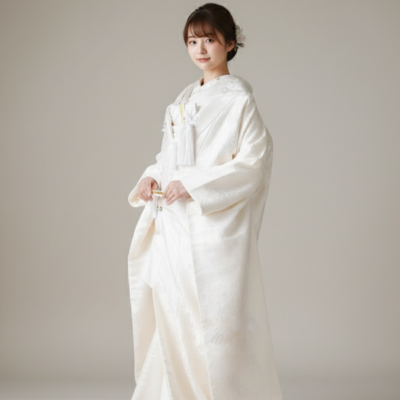
A pure white bridal kimono befitting life’s most radiant moments — symbolizing purity, sincerity, and sacred beauty.
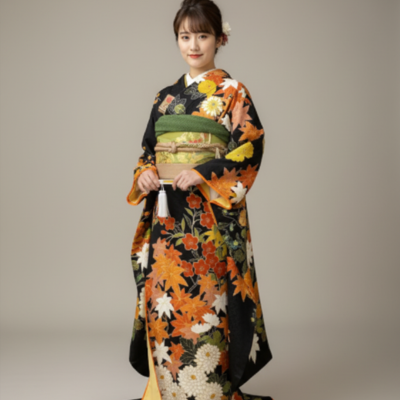
The highest formal kimono for unmarried women, distinguished by its vibrant patterns and gracefully long sleeves — perfect for celebratory occasions such as Coming-of-Age ceremonies and weddings.
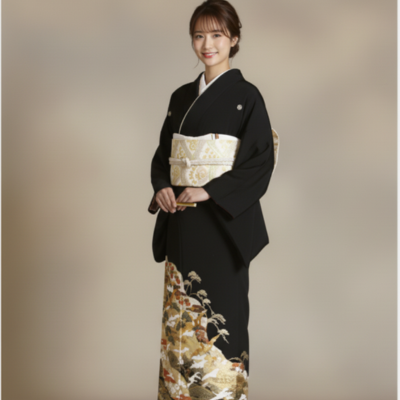
The highest formal kimono for married women, adorned with elegant gold and silver embroidery along the hem — traditionally worn by family members at prestigious ceremonies and celebrations.
Kuro Habutae Montsuki (Formal Five-Crest Kimono with Haori and Hakama)
The most formal attire for men, exuding dignity and composure. Traditionally worn at weddings and official ceremonies, this ensemble commands respect with its understated elegance.
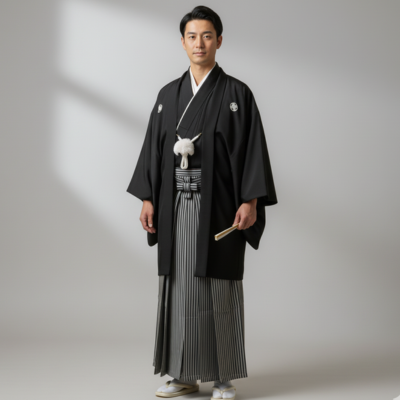
The highest formal attire for men — a traditional outfit of dignity and grace, perfectly suited for distinguished ceremonies and formal occasions.
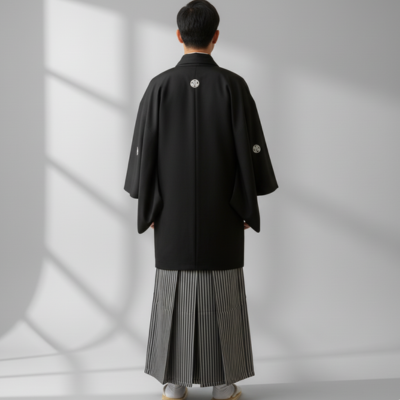
Featuring family crests on the back and both sleeves, this classic ensemble embodies refinement and the highest level of formality.
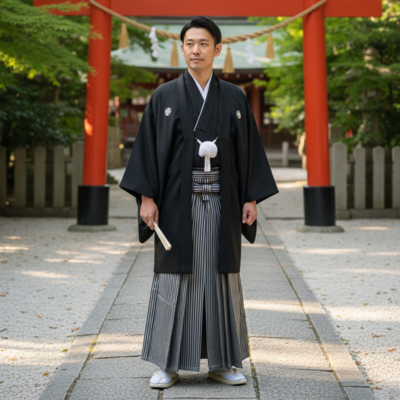
A dignified first-class formal attire, perfectly suited for weddings and ceremonial occasions, evoking a sense of solemn grace.
Semi-Formal (Informal Dress) — The Most Versatile Style for Smart and Stylish Occasions
In modern life, semi-formal kimono may be the most versatile and frequently worn of all.
From a friend’s wedding to your child’s entrance or graduation ceremony, and even to small parties or elegant dinners — owning just one semi-formal kimono gives you a dependable companion that helps you feel confident in any setting.
Its greatest charm lies in its adaptability — by simply changing the obi or accessories, you can completely transform your look. This is where the true joy of kimono coordination begins: discovering your own personal style.
For men, the basic semi-formal style consists of a colored montsuki kimono paired with haori and hakama.
Choosing shades other than black adds a refined, stylish touch, while wearing a haori brings an instant sense of formality and composure.
[Women’s Examples]
・Furisode (Long-Sleeved Kimono)
A formal kimono for unmarried women, full of youthful elegance and charm. The long, flowing sleeves create a graceful and celebratory impression, perfect for Coming-of-Age ceremonies or wedding receptions.
・Hōmongi (Visiting Kimono)
Recognized by its stunning e-ba moyō — a continuous pattern that flows like a single painting from shoulder to hem. This versatile and highly popular kimono can be worn to almost any formal social event.
・Tsukesage (Semi-Formal Patterned Kimono)
Slightly more subdued than the hōmongi, with all motifs oriented upward. It conveys quiet sophistication and allows you to enjoy understated elegance.
・Iro-Muji (Solid-Colored Kimono, One to Three Family Crests)
A “magical” kimono that transforms completely depending on the obi and accessories. Adding even one crest expands its versatility across various occasions.
・Edo Komon (Fine Patterned Kimono, Three Family Crests)
Distinguished by its intricate, almost invisible fine patterns that appear solid from a distance. Subtle yet deeply refined, it embodies the chic elegance of the mature kimono wearer.
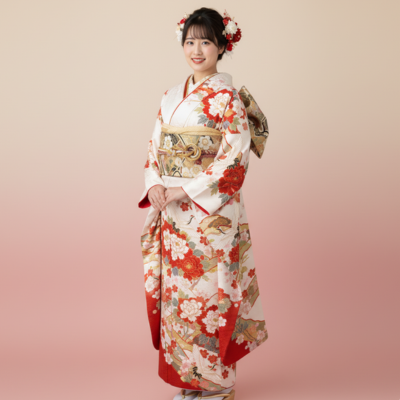
The highest formal kimono for unmarried women, featuring vibrant patterns and elegantly long sleeves — a graceful attire perfect for joyful occasions such as Coming-of-Age ceremonies and weddings.
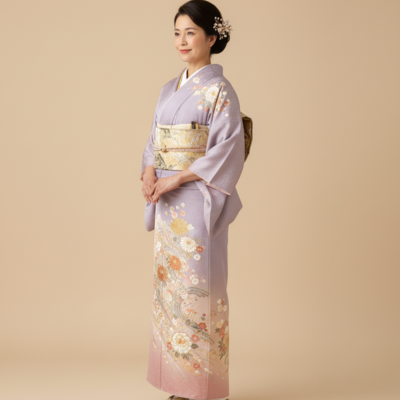
A semi-formal kimono distinguished by its elegant, continuous patterns — suitable for a wide range of formal occasions such as weddings of relatives, tea ceremonies, and official gatherings.
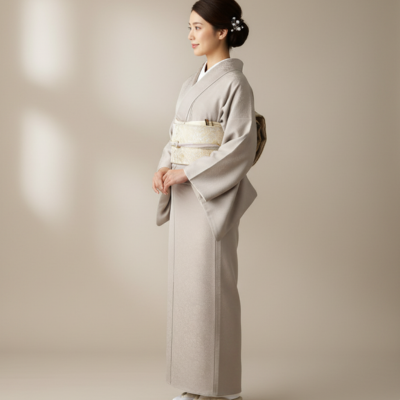
With one family crest, it becomes semi-formal; without a crest, it serves as an elegant casual kimono. A refined and understated choice that carries quiet dignity for various occasions.
[Men’s Examples]
・Iro-Montsuki Haori-Hakama (Colored Formal Kimono with Family Crests)
A timeless and stylish semi-formal ensemble — elegant yet reliable for almost any celebratory occasion.
It consists of a colored kimono and haori (jacket) with one or three family crests, paired with hakama trousers. Perfect for weddings, receptions, and festive gatherings among friends.
・Omeshi Kimono with One Crest
An outfit for the refined gentleman who appreciates subtle sophistication.
Made from omeshi fabric — known for its distinctive textured weave (shibo) and supple comfort — this kimono is often worn in solid colors or with fine patterns. Paired with haori and hakama, it gives an impressively polished, connoisseur’s look.
・High-Quality Tsumugi Kimono with One Crest
A tasteful style for those who value quiet luxury.
Although tsumugi silk was originally everyday wear, a top-quality piece with one crest and haori-hakama pairing becomes an elegant semi-formal choice for relaxed gatherings such as tea ceremonies or casual parties.
It’s understated sophistication — true elegance that only those with an eye for quality will recognize.
・Summer Kimono with One Crest (Rō, Sha, etc.)
An ensemble that balances coolness and courtesy during the summer season.
Made from sheer summer fabrics like rō or sha, this kimono and haori combination shows both refinement and seasonal awareness. Perfect for summer weddings, tea ceremonies, and formal events in warm weather.
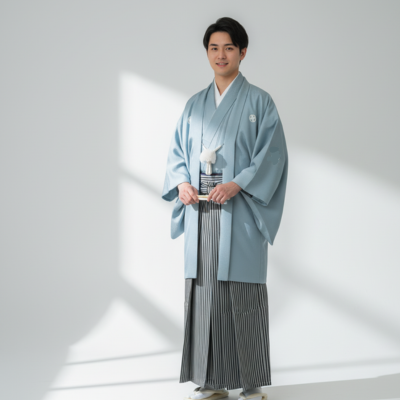
A semi-formal outfit featuring family crests on a colored background — an elegant and refined choice for weddings, celebrations, and other festive occasions.
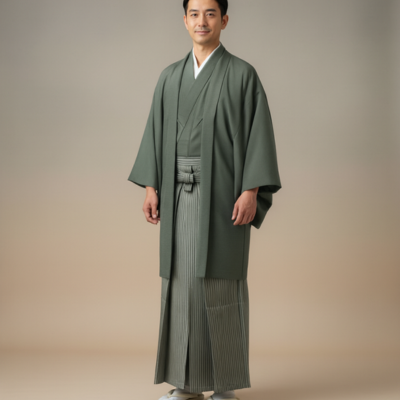
A finely woven kimono favored by connoisseurs, featuring a subtle sheen and smooth texture — suitable for formal dinners and refined ceremonies.
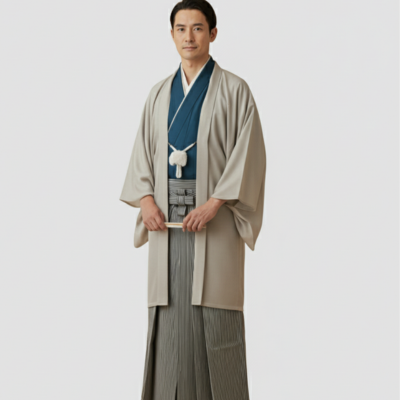
A cool and elegant summer style made from sheer fabrics that allow light to pass through — light, refined, and perfectly suited for formal occasions in the height of summer.
Casual Kimono — “Today, I’m the Star!” Effortless Style That Makes Every Day Special
Now, let’s set aside the rules for a moment and step into the world of freedom in kimono — where the most important thing is simply your desire to wear one.
Just like choosing your favorite outfit from your closet, you can pick colors and patterns that match your mood for the day. That’s the true charm of casual kimono — the joy of dressing for yourself.
And that freedom of style has a kind of magic — it can turn an ordinary day into something special.
A café with friends, a quiet visit to a bookstore… even the simplest moments can become unforgettable memories.
For men, casual kimono are all about ease and comfort. A haori isn’t required — wear it or skip it depending on the weather or your mood, and enjoy the relaxed, effortless look.
In casual kimono, formality doesn’t matter — because the star of the day is you.
[Women’s Examples]
・Komon (Casual Patterned Kimono)
The queen of casual kimono! With endless colors and patterns to choose from, it’s the true star of everyday style — just like your favorite dress in Western fashion.
・Tsumugi & Omeshi (Textured Woven Kimono)
A refined choice for those who appreciate quiet sophistication. These woven kimono have a unique texture that softens and molds to your body over time, offering understated elegance and the charm of iki — effortless chic.
・Momen (Cotton Kimono)
The ultimate everyday kimono you can wash at home — the T-shirt of the kimono world! Easy, carefree, and perfect for beginners who want to enjoy kimono without worry.
・Wool Kimono
Warm, wrinkle-resistant, and easy to care for. Ideal for autumn and winter wear — you can enjoy it as comfortably as a favorite sweater.
・Yukata (Light Cotton Summer Kimono)
Not just for summer festivals or fireworks! Yukata are perfect for relaxed daytime outings, offering the breezy joy that only summer kimono can bring.
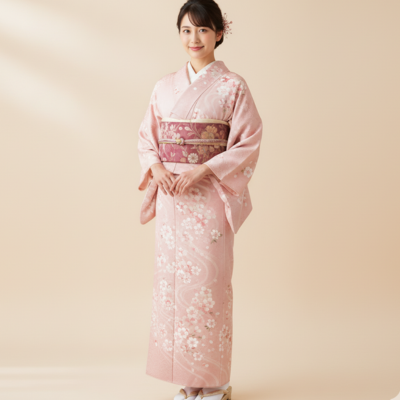
A stylish kimono covered with fine, intricate patterns — perfect for strolls around town or casual gatherings, adding a touch of elegance to everyday outings.
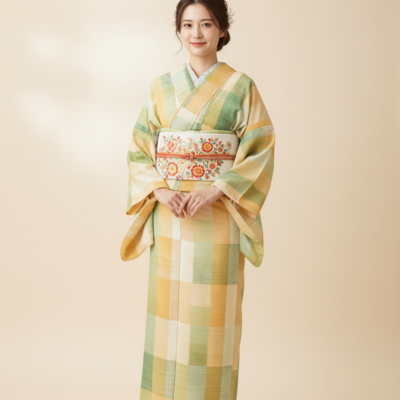
A kimono admired for its handwoven texture and the natural beauty of uneven silk threads. With its subdued colors and refined patterns, it’s perfect for everyday elegance or a day at the theatre.
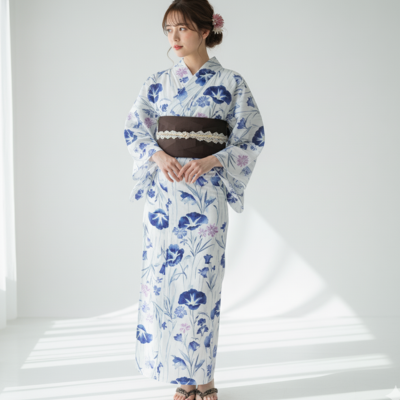
A classic symbol of summer — made of light cotton and often adorned with indigo floral patterns, perfect for evening strolls, summer festivals, and fireworks displays.
[Men’s Examples]
・Tsumugi & Omeshi (Textured Woven Kimono)
Just like for women, these are the staples of men’s casual elegance. Their rich, understated textures highlight the quiet confidence and refined taste of the mature gentleman.
・Wool Kimono
Warm, practical, and easy to wear — an ideal choice for those beginning a kimono lifestyle.
・Momen (Cotton Kimono)
Comfortable and breathable, perfect for active days when ease of movement matters. You can wear it freely without worrying about sweat or dirt.
・Yukata & Jinbei (Casual Summer Wear)
The classic relaxed style for summer. Effortlessly cool and comfortable — ideal for evening strolls or summer festivals.
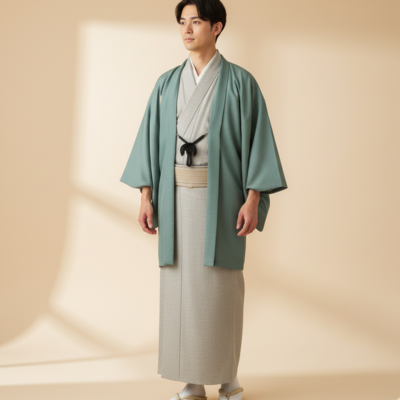
A stylish everyday kimono woven from textured silk threads, prized for its subtle sheen and soft feel — perfect for strolls around town or casual dining occasions.
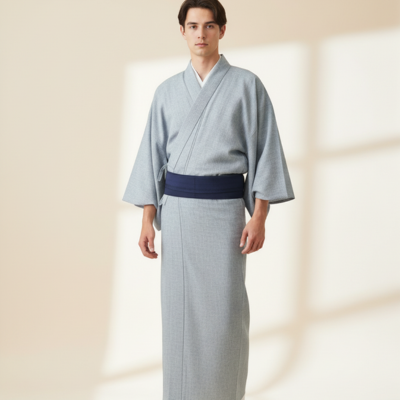
A light and comfortable everyday kimono made from washable fabric — easy to care for and perfectly suited to a modern, casual lifestyle.
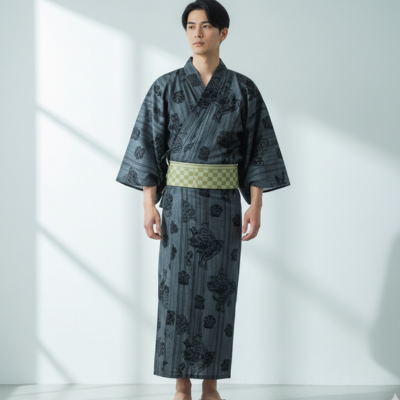
A timeless summer style made of cool, breathable cotton with refined seasonal patterns — perfect for fireworks festivals and evening strolls.
When in Doubt — Your Little “Good-Luck Phrase” for Confident Kimono Dressing
Once you learn about all the different types of kimono, you might find yourself wondering, “So… what should I wear in this situation?”
In those moments of uncertainty, there’s a simple phrase I’d like you to keep close to your heart — your little “good-luck words.”
They are:
“Never forget respect for the host, and add just a touch of grace to the occasion.”
As long as you hold on to that feeling, you’ll never go wrong.
With that in mind, let’s look at a few practical tips to help you choose with even more confidence.
1. Let “Place, Company, and Purpose” Be Your Guide
When in doubt, return to the basics of TPO — Time, Place, and Occasion.
Ask yourself: Where am I going? Who will I meet? What will I be doing?
These three questions are your most reliable compass for choosing the right kimono.
2. When Unsure, Choose “Slightly Understated” — The True Art of Iki
If you ever think, “Is this a bit too flashy?” it’s often wise to take one step down in formality.
After all, the spotlight should always shine on the host or the purpose of the event — not on you.
That quiet sense of restraint, that touch of modesty, is what others will see as refined and truly elegant.
3. Your Secret Weapon — The “Magic Question”
There’s one foolproof, graceful trick that never fails — and it even makes others happy.
Before the event, gently ask:
“May I ask what kind of attire everyone will be wearing?”
This simple, considerate question is pure magic: it builds connection and ensures you’ll never be out of place.
Conclusion | Welcome to the Start of Your Personal Kimono Story
Thank you so much for reading to the end.
At first, words like TPO and formality might have sounded complicated — perhaps even a little rigid.
But once you understand the basics, they open the door to greater freedom, confidence, and self-expression through kimono.
If this article has helped you feel even a little of that joy, nothing could make me happier.
A kimono that expresses your feelings on formal occasions.
A kimono that adds grace and warmth when you’re a guest.
And a kimono that turns an ordinary day into something special.
May your wardrobe continue to fill with these beautiful garments — each one carrying its own story, ready to become part of yours.
“You might be thinking, ‘I want to enjoy kimono more wisely — with fewer pieces!’
If you’ve already mastered the basics, that’s probably the next thought that comes to mind.
In fact, even a single kimono can completely transform its impression, almost like magic, just by changing the obi and accessories.
This article reveals the secret behind that transformation — the art of “kimono coordination that changes with every occasion.”
Take a look at the next step below and discover how it works in detail.
▶ One Kimono, Many Moods – How to Dress Gracefully for Every Occasion
